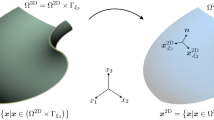Conclusions
-
1.
An analysis of the stresses arising in the cross section of the tibia in human walking showed that the greatest tensile stress in walking is found for zone 1.
-
2.
Normal compact bone tissue is well adapted to physiological stresses while demineralized bone is well adapted to ultimate stresses. This finding supports the hypothesis that the adaptation of compact bone tissue to physiological stress levels is largely achieved by change in the concentration of mineral components in the tissue.
-
3.
The nonuniformity in the mechanical properties of the organic matrix of compact bone tissue is apparently innate in nature. A decrease in heterogeneity is found with increasing age as a result of a nonuniform change in the properties of the bone organic matrix and the deposition of mineral components in the tissue.
-
4.
The inner layer of the human tibial diaphysis is more rigid and has a higher concentration of mineral components than the outer layer. This produces a definite adaptation of bone to mechanical stresses and the smoothing out of stresses over the thickness of the compact bone layer upon eccentric compression.
Similar content being viewed by others
Literature cited
I. V. Knets, Yu. Zh. Saulgozis, and Kh. A. Yanson, “Deformability and strength of compact bone tissue in tensile stressing,” Mekh. Polim., No. 3, 501–506 (1974).
Yu. Zh. Saulgozis, I. V. Knets, and Kh. A. Yanson, “Transverse deformation coefficients of human compact bone tissue,” Mekh. Polim., No. 6, 1089–1100 (1973).
E. Amtmann, “Mechanical stress, functional adaptation and variation of structure of the human femur diaphysis,” Ergeb. Anat. Entwicklungsgesch.,4, 1–89 (1971).
Yu. Zh. Saulgozis, L. I. Slutskii, I. V. Knets, and Kh. A. Yanson, “A study of the relationships between various mechanical properties and the biochemical composition of human bone tissue.,” Mekh. Polim., No. 1, 138–145 (1973).
B. K. F. Kummer, “Biomechanics of bone: Mechanical properties, functional structure, functional adaptation,” in: Biomechanics: Its Foundations and Objectives, Prentice-Hall, Englewood Cliffs, New Jersey (1972), pp. 237–271.
I. V. Knets, G. O. Pfafrod, and Yu. Zh. Saulgozis, The Deformation of Hard Biological Tissue [in Russian], Riga (1980).
M. A. Dobelis, “The deformation properties of demineralized human compact bone tissue upon tensile stressing,” Mekh. Polim., No. 1, 101–108 (1978).
M. A. Dobelis and B. O. Ozola, “The effect of biochemical composition on the mechanical properties of normal and demineralized compact bone tissue,” in: Abstracts of the Second Conference of Young Specialists on the Mechanics of Composite Materials [in Russian], Riga (1979), pp. 24-26.
Kh. A. Yanson, The Biomechanics of the Human Lower Extremity [in Russian], Riga (1975).
B. K. F. Kummer, “Die Biomechanik der aufrechten Haltung,” Mitt. Naturforsch. Ges. Bern,22, 239–259 (1965).
T. Kimura, “Mechanical characteristics of human lower leg bones,” J. Fac. Sci. Univ. Tokyo Sec. 5,4, 319–393 (1974).
M. A. Dobelis, “Age-related changes in several mechanical indices of demineralized compact bone tissue,” Mekh. Komp. Mater., No. 5, 868–872 (1979).
P. Blaimont and P. Halleux, “Un paradoxe des contraintes osseuses. Rôle du remaniement haversien dans l'adaptation de l'os à sa fonction de soutien,” Acta Orthop. Belg.,38, Suppl. 1, 63–77 (1972).
Kh. A. Yanson, G. R. Bite, I. V. Knets, and Yu. Zh. Saulgozis, “The hardness of the human tibia,” Mekh. Polim., No. 6, 1101–1107 (1973).
Author information
Authors and Affiliations
Additional information
Translated from Mekhanika Kompozitnykh Materialov, No. 2, pp. 322–329, March–April, 1982.
Rights and permissions
About this article
Cite this article
Dobelis, M.A., Saulgozis, Y.Z. Effect of functional adaptation on nonuniformity in the mechanical properties of the tibia. Mech Compos Mater 18, 229–234 (1982). https://doi.org/10.1007/BF00604847
Received:
Issue Date:
DOI: https://doi.org/10.1007/BF00604847




